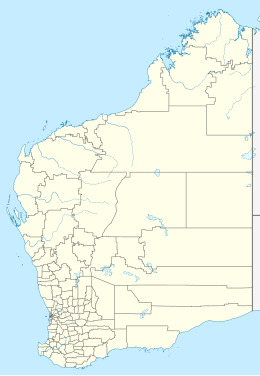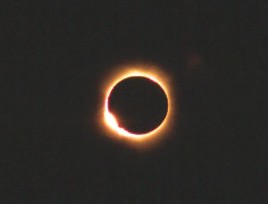
A total solar eclipse took place on December 4, 2002, with a magnitude of 1.0244. A solar eclipse occurs when the Moon passes between Earth and the Sun, thereby totally or partly obscuring the image of the Sun for a viewer on Earth. A total solar eclipse occurs when the Moon's apparent diameter is larger than the Sun's, blocking all direct sunlight, turning day into darkness. Totality occurs in a narrow path across Earth's surface, with the partial solar eclipse visible over a surrounding region thousands of kilometres wide. It was visible from a narrow corridor in southern Africa, the Indian Ocean and southern Australia. A partial eclipse was seen from the much broader path of the Moon's penumbra, including most of Africa and Australia. During the sunset after the eclipse many observers in Australia saw numerous and unusual forms of a green flash.
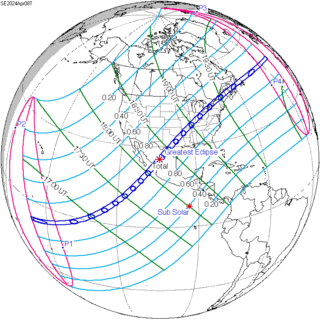
A total solar eclipse will take place at the Moon's ascending node on Monday, April 8, 2024, visible across North America and dubbed the Great North American Eclipse by some of the media. A solar eclipse occurs when the Moon passes between Earth and the Sun, thereby obscuring the image of the Sun for a viewer on Earth. A total solar eclipse occurs when the Moon's apparent diameter is larger than the Sun's, blocking all direct sunlight, turning day into darkness. Totality occurs only in a narrow path across Earth's surface, with the partial solar eclipse visible over a surrounding region thousands of kilometres wide.
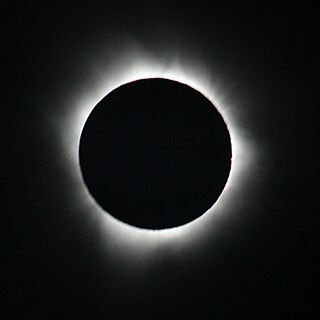
The total solar eclipse of July 11, 2010, occurred over the southern Pacific Ocean. A solar eclipse occurs when the Moon passes between Earth and the Sun, thereby totally or partly obscuring the image of the Sun for a viewer on Earth. A total solar eclipse occurs when the Moon's apparent diameter is larger than the Sun's, blocking all direct sunlight, turning day into darkness. Totality occurs in a narrow path across Earth's surface, with the partial solar eclipse visible over a surrounding region thousands of kilometres wide. This eclipse was on the same day as the 2010 FIFA World Cup Final.
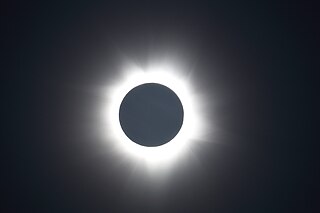
A total solar eclipse took place on 13–14 November 2012 (UTC). Because it crossed the International Date Line it began in local time on November 14 west of the date line over northern Australia, and ended in local time on November 13 east of the date line near the west coast of South America. Its greatest magnitude was 1.0500, occurring only 12 hours before perigee, with greatest eclipse totality lasting just over four minutes. A solar eclipse occurs when the Moon passes between Earth and the Sun, thereby totally or partly obscuring the image of the Sun for a viewer on Earth. A total solar eclipse occurs when the Moon's apparent diameter is larger than the Sun's, blocking all direct sunlight, turning day into darkness. Totality occurs in a narrow path across Earth's surface, with the partial solar eclipse visible over a surrounding region thousands of kilometres wide.
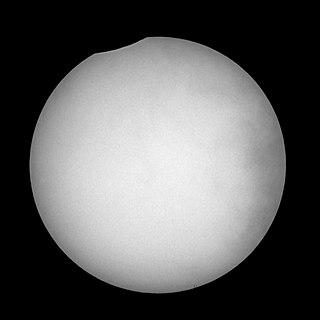
A partial solar eclipse occurred on Friday, July 13, 2018. A solar eclipse occurs when the Moon passes between Earth and the Sun, thereby totally or partly obscuring the image of the Sun for a viewer on Earth. A partial solar eclipse occurs in the polar regions of the Earth when the center of the Moon's shadow misses the Earth. The moon's penumbra touched a small part of Antarctica, and southern Australia in Tasmania, where the eclipse was observed with a magnitude of about 0.1. The eclipse was also visible in Stewart Island, an island south of New Zealand.

A total solar eclipse will occur on Saturday, August 12, 2045, when the Moon passes between Earth and the Sun, thereby totally or partly obscuring the image of the Sun for a viewer on Earth. A total solar eclipse occurs when the Moon's apparent diameter is larger than the Sun's, blocking all direct sunlight, turning day into darkness. Totality occurs in a narrow path across Earth's surface, with the partial solar eclipse visible over a surrounding region thousands of kilometres wide.

A total solar eclipse occurred at the Moon's ascending node of the orbit on Saturday, October 23, 1976. A solar eclipse occurs when the Moon passes between Earth and the Sun, thereby totally or partly obscuring the image of the Sun for a viewer on Earth. A total solar eclipse occurs when the Moon's apparent diameter is larger than the Sun's, blocking all direct sunlight, turning day into darkness. Totality occurs in a narrow path across Earth's surface, with the partial solar eclipse visible over a surrounding region thousands of kilometres wide. This total solar eclipse began at sunrise in Tanzania near the border with Burundi, with the path of totality passing just north of the large Tanzanian city of Dar es Salaam. It then crossed the Indian Ocean, passing St. Pierre Island, Providence Atoll and Farquhar Atoll of Seychelles before making landfall in southeastern Australia. The largest city that saw totality was Melbourne. After leaving the Australian mainland, the path of totality left the Earth's surface just north of the north island of New Zealand.
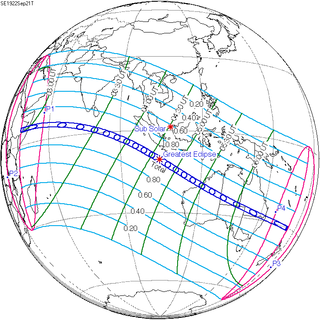
A total solar eclipse occurred on September 21, 1922. A solar eclipse occurs when the Moon passes between Earth and the Sun, thereby totally or partly obscuring the image of the Sun for a viewer on Earth. A total solar eclipse occurs when the Moon's apparent diameter is larger than the Sun's, blocking all direct sunlight, turning day into darkness. Totality occurs in a narrow path across Earth's surface, with the partial solar eclipse visible over a surrounding region thousands of kilometres wide. The greatest eclipse occurred exactly at perigee.

A hybrid solar eclipse occurred on Thursday, April 20, 2023. A solar eclipse occurs when the Moon passes between Earth and the Sun thereby totally or partly obscuring the Sun for a viewer on Earth. A hybrid solar eclipse is a rare type of solar eclipse that changes its appearance from annular to total and back as the Moon's shadow moves across the Earth's surface. Totality occurs in a narrow path across the surface of the Earth, with the partial solar eclipse visible over a surrounding region thousands of kilometers wide. Hybrid solar eclipses are extremely rare, occurring in only 3.1% of solar eclipses in the 21st century.
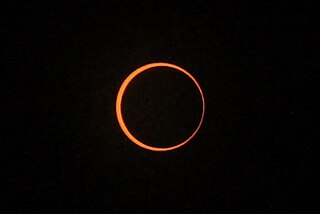
An annular solar eclipse occurred on October 14, 2023. A solar eclipse occurs when the Moon passes between Earth and the Sun, thereby totally or partly obscuring the image of the Sun for a viewer on Earth. An annular solar eclipse occurs when the Moon's apparent diameter is smaller than the Sun's, blocking most of the Sun's light and causing the Sun to look like an annulus (ring). An annular eclipse appears as a partial eclipse over a region of the Earth thousands of kilometres or miles wide. Occurring only 4.6 days after apogee, the Moon's apparent diameter was small.

A total solar eclipse occurred on June 20, 1974. A solar eclipse occurs when the Moon passes between Earth and the Sun, thereby totally or partly obscuring the image of the Sun for a viewer on Earth. A total solar eclipse occurs when the Moon's apparent diameter is larger than the Sun's, blocking all direct sunlight, turning day into darkness. Totality occurs in a narrow path across Earth's surface, with the partial solar eclipse visible over a surrounding region thousands of kilometres wide.

An annular solar eclipse occurred on March 18, 1969. A solar eclipse occurs when the Moon passes between Earth and the Sun, thereby totally or partly obscuring the image of the Sun for a viewer on Earth. An annular solar eclipse occurs when the Moon's apparent diameter is smaller than the Sun's, blocking most of the Sun's light and causing the Sun to look like an annulus (ring). An annular eclipse appears as a partial eclipse over a region of the Earth thousands of kilometres wide. Annularity was visible from part of Indonesia, and two atolls in the Trust Territory of the Pacific Islands which belongs to the Federated States of Micronesia now.
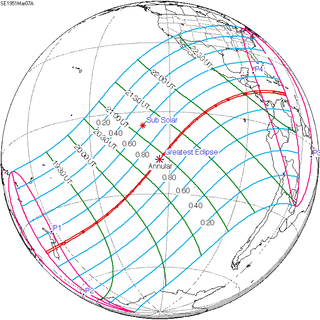
An annular solar eclipse occurred on March 7, 1951, with a magnitude of 0.9896. A solar eclipse occurs when the Moon passes between Earth and the Sun, thereby totally or partly obscuring the image of the Sun for a viewer on Earth. An annular solar eclipse occurs when the Moon's apparent diameter is smaller than the Sun's, blocking most of the Sun's light and causing the Sun to look like an annulus (ring). An annular eclipse appears as a partial eclipse over a region of the Earth thousands of kilometres wide. Annularity was visible from New Zealand on March 8 (Thursday), and northern Costa Rica, Nicaragua, and San Andrés Island in Colombia on March 7 (Wednesday).
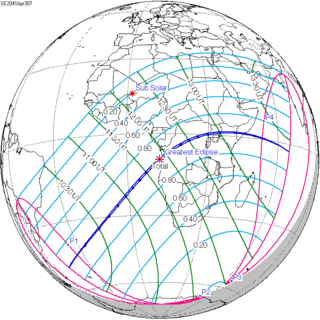
A total solar eclipse will occur on Tuesday, April 30, 2041. A solar eclipse occurs when the Moon passes between Earth and the Sun, thereby totally or partly obscuring the image of the Sun for a viewer on Earth. A total solar eclipse occurs when the Moon's apparent diameter is larger than the Sun's, blocking all direct sunlight, turning day into darkness. Totality occurs in a narrow path across Earth's surface, with the partial solar eclipse visible over a surrounding region thousands of kilometres wide.
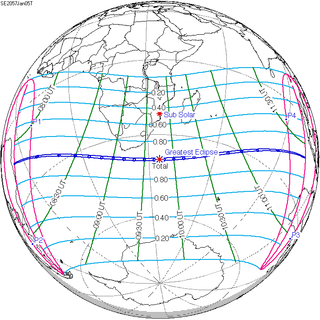
A total solar eclipse will occur on January 5, 2057. A solar eclipse occurs when the Moon passes between Earth and the Sun, thereby totally or partly obscuring the image of the Sun for a viewer on Earth. A total solar eclipse occurs when the Moon's apparent diameter is larger than the Sun's, blocking all direct sunlight, turning day into darkness. Totality occurs in a narrow path across Earth's surface, with the partial solar eclipse visible over a surrounding region thousands of kilometres wide.
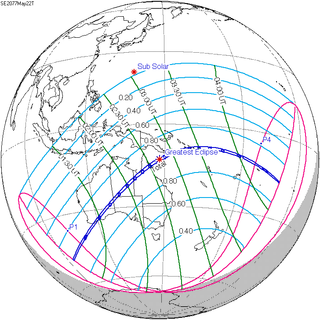
A total solar eclipse will occur on Saturday, May 22, 2077. A solar eclipse occurs when the Moon passes between Earth and the Sun, thereby totally or partly obscuring the image of the Sun for a viewer on Earth. A total solar eclipse occurs when the Moon's apparent diameter is larger than the Sun's, blocking all direct sunlight, turning day into darkness. Totality occurs in a narrow path across Earth's surface, with the partial solar eclipse visible over a surrounding region thousands of kilometres wide.
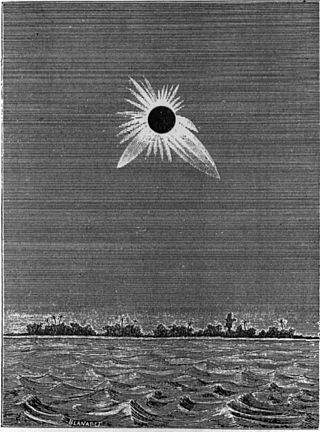
A total solar eclipse occurred on May 6, 1883. A solar eclipse occurs when the Moon passes between Earth and the Sun, thereby totally or partly obscuring the image of the Sun for a viewer on Earth. A total solar eclipse occurs when the Moon's apparent diameter is larger than the Sun's, blocking all direct sunlight, turning day into darkness. Totality occurs in a narrow path across Earth's surface, with the partial solar eclipse visible over a surrounding region thousands of kilometres wide. The path of totality fell across the southern Pacific Ocean with no major landfall. Partiality was visible from far eastern Australia at sunrise, and New Zealand, as well as western South America and southern Mexico near sunset. This eclipse is a member of Solar Saros 136, and its maximum duration was 5 minutes and 58.24 seconds.
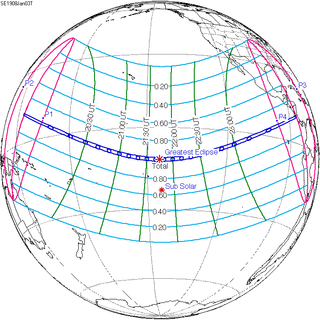
A total solar eclipse occurred on January 3, 1908. A solar eclipse occurs when the Moon passes between Earth and the Sun, thereby totally or partly obscuring the image of the Sun for a viewer on Earth. A total solar eclipse occurs when the Moon's apparent diameter is larger than the Sun's, blocking all direct sunlight, turning day into darkness. Totality occurs in a narrow path across Earth's surface, with the partial solar eclipse visible over a surrounding region thousands of kilometres wide. Totality was visible from Ebon Atoll in German New Guinea, British Western Pacific Territories, Line Islands, Phoenix Islands on January 4 (Saturday), and Costa Rica on January 3 (Friday). The green line means eclipse begins or ends at sunrise or sunset. The magenta line means mid eclipse at sunrise or sunset, or northern or southern penumbra limits. The green point means eclipse obscuration of 50%. The blue line means umbral northern and southern limits.

An annular solar eclipse occurred on February 14, 1915, also known as “The 1915 Valentine’s Day eclipse”. A solar eclipse occurs when the Moon passes between Earth and the Sun, thereby totally or partly obscuring the image of the Sun for a viewer on Earth. An annular solar eclipse occurs when the Moon's apparent diameter is smaller than the Sun's, blocking most of the Sun's light and causing the Sun to look like an annulus (ring). An annular eclipse appears as a partial eclipse over a region of the Earth thousands of kilometres wide. Annularity was visible from Australia, Papua in Dutch East Indies, German New Guinea, and the South Seas Mandate of Japan.
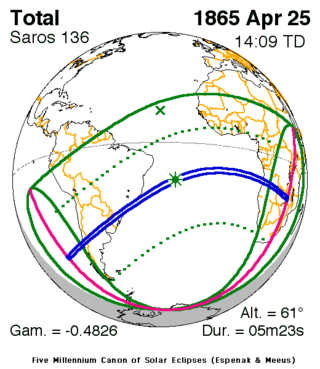
A total solar eclipse occurred on April 25, 1865. A solar eclipse occurs when the Moon passes between Earth and the Sun, thereby totally or partly obscuring the image of the Sun for a viewer on Earth. A total solar eclipse occurs when the Moon's apparent diameter is larger than the Sun's, blocking all direct sunlight, turning day into darkness. Totality occurs in a narrow path across Earth's surface, with the partial solar eclipse visible over a surrounding region thousands of kilometres wide.

